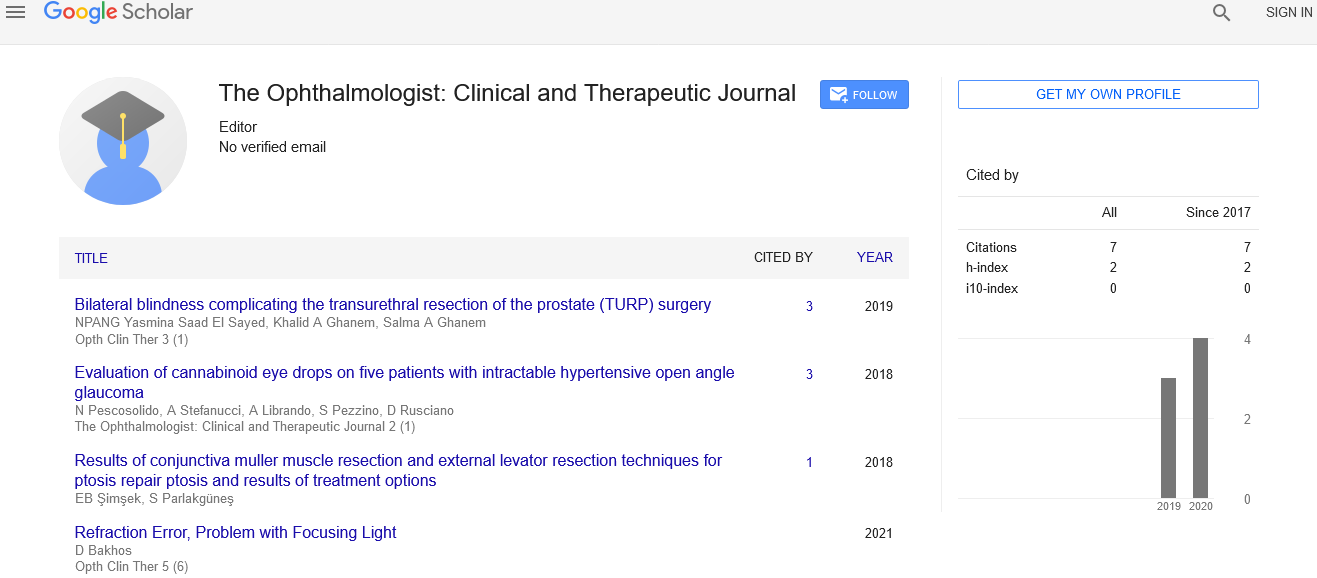Importance of perioperative nonsteroidal anti-inflammatory drugs usage in cataract medical surgery
Received: 12-Apr-2021 Accepted Date: Apr 20, 2021; Published: 28-Apr-2021
Citation: Roy C. Importance of perioperative nonsteroidal anti-inflammatory drugs usage in cataract medical surgery. Opth Clin Ther. 2021;5(2):10.
This open-access article is distributed under the terms of the Creative Commons Attribution Non-Commercial License (CC BY-NC) (http://creativecommons.org/licenses/by-nc/4.0/), which permits reuse, distribution and reproduction of the article, provided that the original work is properly cited and the reuse is restricted to noncommercial purposes. For commercial reuse, contact reprints@pulsus.com
Description
Non-Steroidal Anti-Inflammatory Drugs (NSAIDs) are broadly utilized and read by cataract specialists for shifted benefits in the perioperative period, yet ideal medicine formulae and dosing presently can't seem to be set up. In this article, we play out a writing survey of articles distributed between 1st January, 2019 and 30th March, 2021 concerning perioperative NSAID use for patients going through cataract surgery.
Numerous cataract specialists start NSAID prescriptions for their patients preoperatively to decrease intraoperative prostaglandin discharge and gruff postoperative irritation. In 2020, Katsev, got sequential 100 tests of watery humor in 12 patients going through cataract surgery. Tests were gotten from patients who had gotten effective ketorolac multiple times more than 24 hours preceding surgery and were gathered both after beginning paracentesis, and before corneal injury hydration. Ketorolac fixations were essentially decreased toward the finish of surgery contrasted and the start of surgery (P=0.0022) with 66.7% of patients having imperceptible levels toward the end. Albeit the conceivable stop impact of preoperative ketorolac dosing in the glassy hole stays hazy, the creators noticed that ketorolac's short half-existence of 2.3 hours and the expulsion of free medication by intraoperative water system probably delivers the postoperative anti-inflammatory impacts of preoperative ketorolac negligible. Subsequently, they upheld for intraoperative ketorolac use.
Studies uncovered five spaces of ongoing investigation including preoperative NSAID use for iatrogenic aggravation, intraoperative NSAID use for pupillary mydriasis, postoperative NSAID use for anticipation of Cystoid Macular Edema (CME), for counteraction of torment/irritation, and for development in tolerant personal satisfaction.
Late writing sets up the viability of a recently accessible intracameral phenylephrine-NSAID mix for pupillary mydriasis, postoperative NSAID use for forestalling CME in certain high-hazard populaces, and postoperative
NSAIDs for controlling agony and irritation. In any case, further great investigations are needed to decide the drawn out impacts of perioperative NSAIDs on visual keenness and CME rates.
Nonsteroidal Anti-Inflammatory Drugs (NSAIDs), a class of prescriptions that hinder Cyclooxygenase (COX) catalysts from creating favorable to inflammatory prostaglandins, have different signs in the perioperative period including torment control, lessening irritation, improving intraocular mydriasis, and forestalling postoperative Cystoid Macular Edema (CME). Albeit the expected advantages of NSAIDs in the perioperative period have been known for quite a long time, ideal NSAID drug and dosing regimens presently can't seem to be set up. This article surveys the writing concerning perioperative NSAID use between 1st January, 2019 and 30th March, 2021.
Conclusion
The best utilization of perioperative NSAIDs keeps on being a wellspring of discussion in the ophthalmologic writing. Surveying articles distributed between 1st January, 2019 and 30th March, 2021 uncovered new improvements at each phase of cataract surgery. Perioperative NSAIDs accomplish better intraoperative mydrasis, lower paces of postoperative CME, and improve patient solace following surgery. Further top notch contemplates are expected to build up Level I proof on the drawn out impacts of perioperative NSAIDs on visual keenness and CME rates in generally safe and high-hazard patients.





